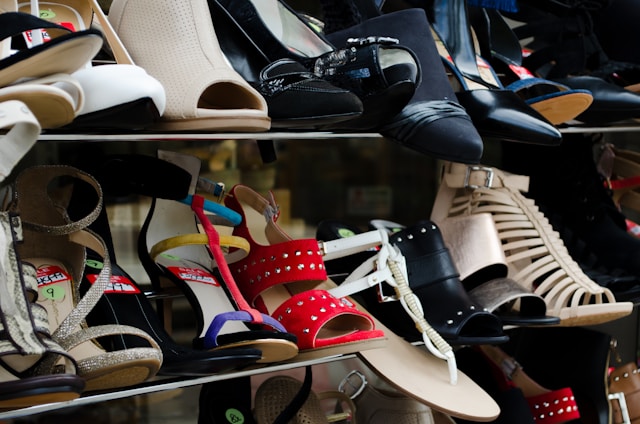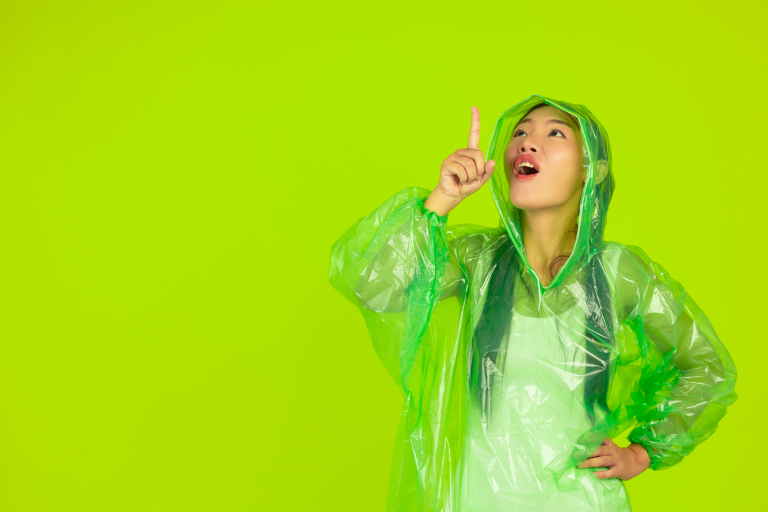Fashion accounts for over ⅕ of the world’s pollution, producing 300 million tons of plastic and 1.3 billion barrels of oil annually. The international outcry for sustainability throughout all areas of life has inspired millions of people across the globe to turn to different sustainable fashion trends such as thrifting, upcycling, and more!
While thrifting is a great alternative to shopping fast fashion brands, some of these sustainable fashion trend act as a band-aid solution to a larger issue: overconsumption.
What is Fast Fashion?
Before getting into why thrifting and similar sustainable fashion trend are not always the most eco-friendly alternatives, it is important to know what these trends hope to fight against fast fashion.
Fast fashion occurs due to the fast-turnover demand for new clothing because of influencing factors. For example, the TikTok green dress went viral in the summer of 2020, causing the dress to sell out in a matter of days. However, buyers were quick to anger as the dress had already phased out of the “trend” by the time they received their package. This happens daily, with fast fashion cycles becoming smaller and smaller because of social media. As a result, clothing production has nearly doubled in the last 15 years, thus the push to minimize its effects.
Fast fashion originates from the Industrial Revolution, innovating machines such as the sewing machine, which revolutionized the speed and scale at which clothes could be produced. Fast fashion takes this revolution to a different scale and makes couture trends cheap and accessible to all. Nevertheless, these trends end up in the garbage within one year of purchase and are often at the expense of bad work environments. This revolution, coupled with short fashion cycles, caused brands such as Forever21 or PacSun to have over 14 different collections per year.
Want to learn more about the history and implications of fast fashion? Check out this article: SOCIAL & ENVIRONMENTAL IMPACT OF FAST FASHION.
Recently, however, thrifting and upcycling have become the staples for sustainable fashion trends as the new generation shifts their shopping needs to second-hand clothing.
Thrifting IS Inherently a Sustainable Fashion Trend
Thrifting as a sustainable fashion trend is a noble pursuit. Thrifting shopping reduces carbon emissions, reduces waste, and eventually reduces demand for textile production, meaning slower fashion, which directly contributes to plastic and oil pollution.
Typically, making clothes takes a lot of work and energy. One pair of jeans uses about 1,800 gallons of water. Coupled with the massive amount of harmful dyes and oil by-products, it is an understatement to say that simply making clothes is a harmful process.

However, even after the clothes are made, they still contribute to pollution, as clothing made from synthetic materials will take hundreds of years to decompose. This is precisely why thrifting is a good option to contribute to the fight to save our planet.
To learn more in-depth details surrounding why thrifting is a sustainable fashion trend, check out this article: “VINTAGE CLOTHING: CAN FASHION EVER BE SUSTAINABLE?”
This sustainable fashion trend has caused the industry to create hundreds of new businesses and jobs post-COVID. Thrift shops now contribute to an over $64 million market, and apps such as TheRealReal, Depop, and ThredUp have caused the industry to flourish into a global phenomenon, bringing “sustainable fashion” to every shop around the corner and even to consumers’ fingertips.
The glorification of thrifting as the new and hip sustainable fashion trend, however, encourages shopping addictions and overconsumption, which in turn contributes to similar issues we are trying to combat.
Overconsumption is the True Villain
While thrifting is indeed a sustainable fashion trend and benefits the environment by reducing the carbon footprint, promoting thrifting as the solution for sustainable fashion has allowed fast-fashion consumption habits to transfer to second-hand clothing.

Thrifting now provides an ethical way for people to interact with fashion. However, this encourages a glorification of consumption. Now, everyone can feel morally obligated to buy more clothes with the money they were already spending on fast fashion and simply re-donate the clothes they don’t need anymore. This turnover cycle causes problems similar to those we encounter in fast fashion.
As stores receive a surplus of donations from shoppers, they are forced to throw away or sell most of their donations to landfills or to other countries. Only 10-20% of donated clothes find their way to the commercial floor.
This means that the other 80% of donations once again lead to pollution, as trips overseas and incinerators in landfills increase the release of greenhouse gases into our atmosphere. So, in reality, thrifting is only a partial remedy for truly sustainable fashion.
Aside from this, thrifting also has a socio-economic impact. As mentioned previously, thrifting was originally a symbol for a lower social class as thrifting allows low-income households to purchase clothing at a lower price.
However, this low pricing has drawn the attention and money of middle and higher-class citizens. In 2020, the COVID-19 pandemic caused the consumer craze for “thrifting hauls,” and consumption habits started to rise.
Due to the increased amount of downtime on nearly everyone’s hands, many turned to online thrift shopping to scavenge for more and more clothes and even hotter deals. This induces the “buy first, think later” mentality to buy what they do not need or even necessarily want simply because of the appeal of the low price. “Since it’s so cheap, even if I only wear it once, I got a good deal” is what I even tend to think when out shopping for specific events.
This increase in demand for second-hand goods, however, resulted in the inflation of prices, further isolating the consumer base that relies on thrift stores the most. As prices started to rise, thrifting shopping was no longer a resource for the working class to engage with fashion. Instead, it has become a playground for higher social classes to feel they have the liberty to overindulge in fast-fashion habits.
While thrifting offers a greener alternative to chain stores, overconsumption risks producing similar amounts of pollution and creating a barrier for already marginalized groups to access necessities. So, to combat overconsumption, we should make minimalist fashion the new sustainable fashion trend.
Minimalist Fashion in Thrifting
While overconsumption won’t be solved in a day, we need to start promoting minimalist fashion as the new sustainable fashion trend. Coupling this minimalist mindset with shopping with thrifting can ensure real progression toward green fashion.
Many times, shoppers are enticed by the great deals and do not look for key “red flags” in clothing. This leads to most clothing sitting in the back of a closet or the bottom of a trash can and just buying more afterward. Being intentional with what we buy is crucial to minimalist fashion. So, when shopping in an attempt to minimize overconsumption, here are 5 Questions to Ask Yourself When Thrift Shopping :
- Would I buy this at retail price?
- What can I wear with this?
- Will I actually repair this?
- Do I own something similar?
- Will This Fit?
Solving the Donation Issue

As mentioned, a reason for the not-so-eco-friendliness of thrifting is because of an influx of donations. Nonetheless, both thrifting and donating should not be criminalized just because of this. Instead, another way to eliminate the effects of thrifting is by redirecting our donation efforts.
Instead of taking your clothes to bigger chain thrift stores such as Goodwill or Salvation Army, take clothes directly to homeless centers or domestic violence centers. Because Goodwill and Salvation Army are so widely known and popular, these bigger chain stores have a huge stock of second-hand products, meaning the odds of your bag of clothing being re-dispersed to others is fairly low.
The odds that your clothes end up getting flamed into waste… are higher. However, ensuring that your clothes go to people in need not only prevents pollution but also allows underprivileged people to regain control of their lives.
These alternatives not only help combat overconsumption and over-donating but also create a pathway towards more sustainable and more empathetic living.
Other Sustainable Fashion Trends
Thrifting, minimalist fashion, and donating to local community centers are great ways to implement smaller changes in your overall shopping habits. However, the battle towards sustainable fashion is still evolving. There are so many other sustainable fashion trends making their way into the fashion industry. For example, renting/trading clothes and innovating new sustainable materials have started gaining popularity.
Trading clothes is a great sustainable fashion trend and an alternative to buying expensive clothes that you only wear once. Apps such as Rent the Runway, Nully, FashionPass, Stitch Fix, and RentMyRunway aim to eliminate the consumption of unnecessary or underworn fashion.

Renting is also a more economical alternative to buying formal wear, as dresses and tuxes tend to be 30-70% less expensive through rentals than retail. This directly combats the overconsumption of clothing that society struggles with today as it satisfies the demand for new clothing.
Aside from trading, there are also developments in new, more sustainable materials to use when making clothing. These materials include organic cotton, recycled polyester, and plant-based textiles. These materials offer ways for bigger fashion companies to start offering their overconsumer customers more sustainable options.
An example of this is H&M, which uses Lyocell in many of its clothing. Lyocell is a cotton-like material made from plant-based cellulose found in wood pulp. This material requires significantly less water and little to no pesticides to make. In addition, they use recycled materials in all of their products. While H&M still contributes to the larger issue of fast fashion, they acknowledge that fast fashion will never completely go away and instead pioneer sustainable materials.
Innovation in new sustainable fashion trends is inspiring and ever-evolving. Thrifting is not the be-all and end-all of eco-friendly fashion. Through similar trends, such as minimalism, fashion rentals, and new materials, we work towards a greener future.
Final Thoughts
Fast Fashion has long been the “evil” that is responsible for one-fifth of the world’s pollution. As society moves towards more sustainability, many look to thrift shopping as the best alternative to combat the high turnover rate of trends in the apparel industry.
While thrifting is a good alternative to shopping at massive chain stores because it reduces the demand for textile production, it should not be the end-all-be-all solution that many people think it is. Overconsumption and overdemand are the original causes of fast fashion, and they do not go away because you start shopping for second-hand clothes. It simply changes form.
The overconsumption of thrifted apparel leads to a fast turnover rate in which people donate clothes at a similar rate to buying new ones. This leads to more carbon emissions from landfills or transportation when these items are sold to other countries. This overindulgence also leads to the isolation of the working and lower class as prices begin to rise to astronomical levels.
To combat the root of fast fashion’s “evil,” we need to fight overconsumption first with a minimalist eye, and not just the type of clothing we buy. This means being intentional, realistic, and frugal with all purchases.
Changing our mindsets entirely will not happen overnight, and it takes practice. Until then, some more alternatives to strengthen our green thumb are donating directly to those in need, renting clothing, and supporting brands with greener materials.
Donating directly to local homeless or domestic violence centers ensures that what we donate will be utilized by others without the possibility of more pollution. Renting clothes and supporting brands with cleaner materials allow the satisfaction of having a new piece of clothing while minimizing pollution.
Utilizing these tips and advice will ensure we can shop more eco-friendly; however, there is always room to do more. Innovations are constantly coming to fruition that can aid in the fight for sustainability. By being conscious of our habits and constantly looking for new alternatives, together, we can create a greener planet.
Implementing Sustainable Practices
After hosting over 650 industry leaders, we’ve found that the key to building a sustainable brand is to simply start. While achieving 100% sustainability is unattainable, setting and working toward a single goal marks significant progress.
Many businesses delay this step, often citing cost concerns or a lack of infrastructure. However, is it truly too expensive to take the first step, or does it require as much structure as assumed? Starting small can pave the way for impactful change. Understand the true meanings of sustainability, and also what it means to you and your brand. Discover more from course Textile Revolution: Sustainability & Innovation in Fashion.
Read Next
To learn more about sustainable innovations and trends, read:
“THE REVOLUTION IN THE FASHION INDUSTRY: EXPLORING HOW TECHNOLOGY IS DRIVING SUSTAINABLE FASHION”





